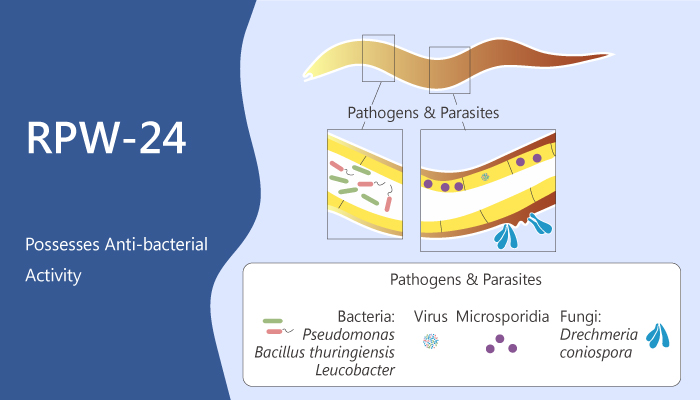Caenorhabditis elegans provides a potential for high throughput, live-animal screening of low molecular weight compound libraries. These are to identify molecules that target multiple cellular processes. The study of the C. elegans model has expanded our understanding of development, neurobiology, host-pathogen interaction and many other aspects of metazoan biology. C. elegans can identify novel antimicrobials in bacterial infection assays. And automating the measurement uses image analysis software. The screening of new anti-infective drugs based on nematodes can identify small molecules that cure nematodes by stimulating the innate immune response of the host. In addition, it can also prevent the toxicity of microorganisms or directly inhibit the growth of bacteria. C. elegans has a highly conserved immune signaling medium. Meanwhile, C. elegans has a specific immune response to both bacterial and fungal pathogens. RPW-24 protects C. elegans from bacterial infection by stimulating the host immune response of the nematode.

RPW-24 strongly stimulates the innate immune response of nematodes by giving them a survival advantage in the process of bacterial infection. In addition, RPW-24 induces transcription of a very small number of C. elegans genes. Meanwhile, it partially depends on the evolutionarily-conserved p38 MAP kinase pathway and the transcription factor ATF-7. Besides by this, RPW-24 promotes resistance to Pseudomonas aeruginosainfection. Specifically, the immunostimulatory activity of RPW-24 is necessary for its efficacy. These demonstrate that C. elegans can be used for simple screening in vivo to identify compounds with required biological activities. All in all, RPW-24 protects C. elegans from bacterial infection by stimulating the host immune response of the nematode. RPW-24 possesses anti-bacterial activity.
References:
Pukkila-Worley R, et al. Nat Chem Biol. 2013 Dec;9(12):796-804.